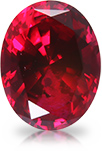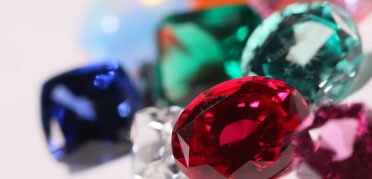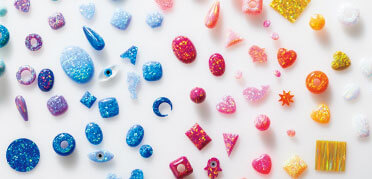Jewelry Glossary
-
R
-
Radiation (Treatment)
Radiation is a method of coloring a colorless stone or changing the color of a gemstone through exposure to radiation.
-
Red Beryl
The color of red beryl is due to the content of manganese which is similar to the color development of morganite. It features a soft and unique red color that has an added sense of elegance unlike other gems such as ruby, spinel, and pyrope garnet.
It is also called "bixbite" and occasionally produced in Utah and New Mexico. Unfortunately, the production cost is high due to the lack of large stones as they rarely appear on the market.
[Moh's hardness: 7] [Mineral species: Beryl] -
Red Spinel
The red color of red spinel is derived from its content of chrome and iron. The different qualities of red spinel are divided into the dark color from Myanmar Mogok and the light color from Tanzania.
Orangesh red spinel is also called raspberry spinel.
[Moh's hardness: 8] [Mineral species: Spinel] -
Refractive Index
The ray changes its direction when passing from one material to another. Therefore, each gemstone has a unique refractive index
-
Rhodium
In order to prevent sulfating, silver jewelry is usually plated by rhodium.
-
Rhodochrosite
Rhodochrosite is a mineral that shows attractive red and pink color. It started to be sold in the market in the 1940s, so it is a relatively new gemstone. Its pink color comes from manganese and is also mined from silver, copper and lead deposit. Rhodochrosite has low hardness and strong cleavage, so it requires high polishing technique and needs to be treated carefully as a jewelry. In recent years, rhodochrosite with stripe patterns are also called "Inca rose."
[Moh's hardness: 4] [Mineral species: Rhodochrosite] -
Rhodolite Garnet
Rhodolite garnet takes its name from rhoda which means rose in Greek and lithos which means stone. Purplish red stones are considered of higher quality.
[Moh's hardness: 7] [Mineral species: Pyrope garnet / Almandite garnet] -
Rhodonite
Roadnite is a gemstone with a beautiful rose red, and it was named from "rhodon," which means rose in Greek. Roadnite is a beautiful gemstone but inexpensive because there is relatively large production.
[Moh's hardness: 5] [Mineral species: Rhodonite] -
Rim Setting
A gemstone set by rim setting is surrounded by a metal rim. This design makes the jewelry look simple and rarely gets caught because it doesn't have any prongs.
There is also a style with mill graining around the metal rims applying this method. -
Ring
A ring is jewelry worn on the finger. Please see the following image for the names of each part.


- Ring -

-
Ring Size
In Japan, the popular ring size is #10-#12, so many brands make a #11 series.
The size display is not the same from country to country. -
Rock Crystal
Rock crystal is a transparent quartz. In order not to confuse them with "crystal glass," which is a colorless and transparent glass that appeared in the late Middle Ages, transparent quartz is referred to as "rock crystal" instead of simply calling it a crystal.
[Moh's hardness: 7] [Mineral species: Quartz] -
Rock Surface Texture / Skin of Bark Texture
These textures are named after the textures they visually resemble ("Rock" and "Tree bark").
-
Rope Chain
A rope chain is made by braiding a wire or a metal piping into a rope shape.
This chain matches very well with a large pendant. -
Rope Setting
Rope setting is a style of lemon setting.
The metal is curved diagonally like a rope as if its continuous shape looks like a wired rope. The gemstone is fixed by two prongs (top and bottom) for this setting. -
Rose Cut
The rose cut is a historic cut that was already used in Western countries at the beginning of the 16th century. The back side has no pavillion and is flat while the front side is slightly inflated.
All surfaces are covered by triangular facets and resembles the appearance of the rose buds from which the name originates. There is no pavilion so it can not catch the light as the brilliant cut can since the light from the surface leaks out from the bottom to give this cut an understated yet beautiful sparkle. -
Rose Quartz
The color of rose quartz is pale pink. This gem contains fine crystal needles of rutile, so seems white and muddy. Small amounts of titanium makes the gem pink. It is usually produced in large pieces, they have been used as a material for sculptures since ancient times. Some rose quartz is cut into beads and cabochons to make necklaces.
[Moh's hardness: 7] [Mineral species: Quartz] -
Rough Stone
Gemstones that have not been cut/polished. Stones before a loose stone.
-
Royal Blue
Royal blue is another hue of sapphire, it is slightly purple and blue. This color is present in large sized sapphires usually more than 3ct however it remains quite rare.
-
Rubellite
"Rubellite" is a tourmaline of deep red or red purple like ruby. It was once used as a substitute for ruby. The pink tourmaline is lighter in pink color than rubellite.
[Moh's hardness: 7] [Mineral species: Tourmaline] -
Ruby
The origin of the word "ruby" is "rubeus" which means red in Latin. The red coloration depends on the content of chromium. The history of the mines in the Mogok region of Myanmar is long and in the years has become a major production area of rubies since the 15th century. The feature of Mogok-produced rubies are highly transparent and the ideal intensity of red.
High-quality rubies are worth about 4 million yen per 1 ct. 10ct pieces of high quality ruby are incredibly rare as only as few as 30 pieces have been produced in the past 600 years. There are very few newly produced large pieces of ruby. Many rubies in the jewelry market including Mogok rubies are heat treated.
Kyocera's Crescent Vert ruby has an identical composition as natural rubies, they are grown with care to radiate the enchanting crimson color and high transparency of natural stones.
Please click
here
to learn more about the details of Kyocera's Crescent Vert ruby.

Ruby

The deep red color of ruby conjures passion and sensuality. Treasured since ancient times, ruby was used in amulets and secret medicines. Second only to diamond in hardness, ruby is made of corundum alumina. The finest natural rubies from Myanmar are called “pigeon blood” rubies, prized for their bright red, slightly purplish hue. Crescent Vert ruby is grown with care to radiate the enchanting crimson color and high transparency of natural stones.
Available in sizes up to 10 carats.* If you need a larger stone, please contact us.View Comparison Table Item Crescent Vert Ruby Natural Ruby Chemical Composition Al2O3 Al2O3 X-ray Diffraction Same as natural stone A pattern specific to Ruby Spectroscopic Analysis Same as natural stone Specific absorption of Ruby Crystal system Hexagonal Hexagonal Mohs Hardness 9 9 Specific Gravity 4.01 3.90~4.01 Melting Point 2050℃ 2050℃ Transparency Transparent Transparent Refractive Index 1.762~1.770 1.760~1.768 Double Refraction 0.008 0.008 Average Dispersion 0.018 0.018 Pleochroism Yellow-Red, Bright red Pale yellowish red, Pale red Chelsea Color Filter Examination Strong bright red Strong bright red
[Moh's hardness: 9] [Mineral type: Corundum] -
Ruthenium
Ruthenium is usually used as an alloy metal, and it is highly solid.
-
Rutilated Quartz
Rutilated quartz contains needle rutile crystals. High quality examples have rutiles placed in a well-balanced manner.
[Moh's hardness: 7] [Mineral species: Quartz]
-




